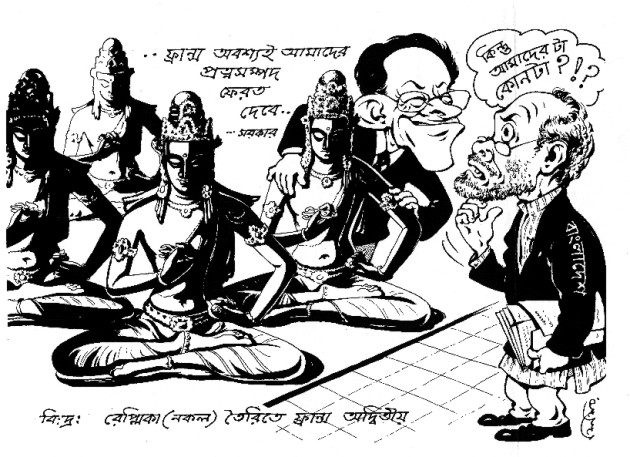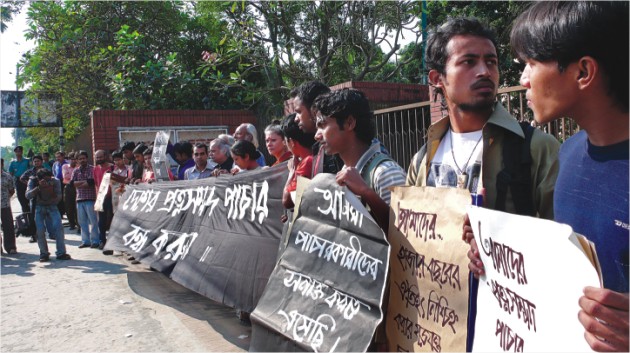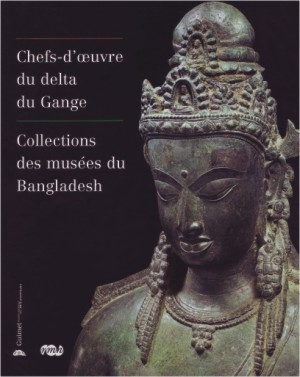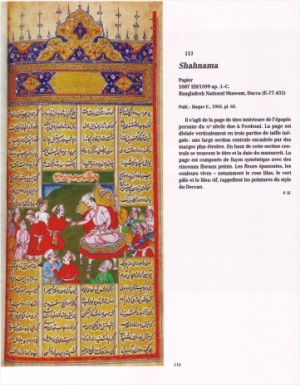
Inside
|
Asterix and the Big Fight
NAEEM MOHAIEMEN reconsiders the Guimet fiasco as an attempt by local cultural activists to create new spaces for resistance.

Photo: SHISHIR BHATTACHARJEE/PROTHOM ALO
“The deaf mute has no enemies in this city" -- this was the only advice to me, from the director of a Dhaka art centre. I had returned to the city after a month break. In the interim, I had been hearing, on email and on blogs, all manner of chatter about a big conflagration between Bangladesh and France. Over art of all things, about a museum loan.
I expected to come back and get inside a fray. But the director was sounding a word of caution. Take some time to absorb, think before you dive in. It was halfway through 2007. The controversy, brewing for a few months, was over the Musée Guimet's Masterpieces of the Ganges Delta: Collections from the Bangladesh Museums show in Paris. By the time I returned to Dhaka, it had taken on Rashomon tones. Each side had a passionate, diametrically opposed reading of events. Seen one way, it was French diplomatic arrogance and cultural over-reach, presuming Bengalis didn't know how to handle their own heritage. Seen another way, it was Bengali shadow politics over internal schisms, with the museum objects a sideshow.
At issue was whether a loan of Bangladeshi artefacts could be made to a French museum on fair terms. The Guimet project was soon over-taken by a maelstrom of events: the French embassy waged ham-fisted diplomacy, court cases blocked the museum loan, protesters surrounded Dhaka museum, and finally, a crate full of artefacts was stolen from the airport tarmac. After the theft, the Bangladesh government cancelled the entire loan, the Musée Guimet suffered "Annulée" signs on Paris posters and at least half a million euros of losses.
A heated culture war, where a French museum became embroiled in controversy and issues of cultural appropriation and theft, played out on Dhaka streets. But at a distance of three years, I started to think through whether other readings were possible: a showdown as an attempt by local cultural activists to create new spaces for resistance. The real target not the French, or the museum, but possibly, indirectly the military-backed Caretaker Government on whose watch the loan was going through. A museum exchange as a proxy war: a rehearsal or proving ground for alternate modes of resistance. A jittery, fragmented performance of politics in one space (cultural nationalism) allowing resistance communities to be built up on the main stage (democracy movement).

Photo: SHAHIDUL ALAM/DRIK/MAJORITY WORLD
Mercury rising
In 2007, an agreement was signed to host Masterpieces of the Ganges Delta at the Musée Guimet in Paris. There was excitement in the world archaeological community, because many of these fragile masterpieces had never been shown outside Bangladesh. The region is associated with dynasties going back to 4th century BCE and Paharpur is identified as one of the oldest Buddhist monasteries in the subcontinent (on UNESCO's list of protected monuments). The 188-piece collection that was to be loaned is mostly Buddhist, Hindu and Jain artefacts and a smaller section of Islamic material. The exhibition was part of a Bangladesh-France joint project, which started with the 1992 excavations at Mahasthan. After the exhibition of the excavation results at Bangladesh National Museum in 1999, a larger show was to be organised in France. The French Embassy also expressed a wish to train local experts in museum preservation science, as part of knowledge and technology transfer.
The Guimet staff started coming to Bangladesh from 2002, to organise training seminars for the staff of the National Museum and the Department of Archaeology. The exhibition, which became an official project in 2005, was to be another step in this Bangla-French cooperation. The Guimet's web site proudly announced: "Bangladesh possesses an immensely important cultural heritage, this arising from the fact that the eastern half of Bengal has been one of the cultural richest regions of the Indian world."
Some time in 2006, a group of protestors started charging irregularities in the Guimet show arrangements. Bangladesh has a very unfortunate history of art theft. Thin borders with India and Burma, little enforcement and corrupt officials make stealing archaeological objects relatively easy. When the 1977 Ad Hoc Committee on the Return and Restitution of Cultural Property to its Countries of Origin (ICOM) carried out a case study of countries that had lost part of their cultural heritage, Bangladesh was one of the countries identified. Firoz Mahmud and Habibur Rahman also document art theft in Museums of Bangladesh (Dhaka, 1987). The trade in stolen objects is assisted at all levels -- the former director of a national museum, as well as a senior diplomat from a foreign mission, were among those accused in the past of being involved in art smuggling.
A group of "concerned citizens" filed a lawsuit in court blocking the Guimet loan. Protest letters started appearing in newspapers. The court eventually rejected the lawsuit. Now, more heavy-hitters became involved and a second lawsuit was filed. In the interregnum between lawsuits, one shipment was sent to the airport. Here, it was intercepted in the cargo holding by the DGFI and sent back to the museum. Things were getting serious. Intellectuals lined up on both sides of the debate. Who was actively involved in the museum loan, and who stayed outside, was an important marker, a red line. It felt like civil war within Bangladesh's shushil shomaj.
The press went high intensity: "Guimet can't be trusted." This was puzzling, as the French are not usually targets for local suspicion (at best, indifference). It is usually India whose involvement makes for tense politics (as per Zafar Sobhan, "India is the third rail of Bangladeshi politics."). But here, suddenly, anti-French sentiment bubbled up with no past history and certainly no colonial relationship. The French embassy was a key factor, continuously aggravating tensions with their undiplomatic statements: "It is time for the few opponents to this event to recognize they are a tiny minority and act accordingly." The mercury shot up. How dare the French, wrote bloggers, we won't be treated this way. A second concentric circle (anthropologists, art historians and journalists) now formed around the nucleus of protesters.
The substantial issues being raised repeatedly were: lack of transparency, inconsistent inventory numbers, missing accession numbers and poor paperwork. Much of this could have been the result of incompetence on both Bangladeshi and French sides, but it took months to clear up the confusion (in a series of increasingly disorganised press conferences). The core conflict was also over the insurance value for the collection -- initially reported to be one million euros. An international archaeological expert called this valuation "financial fraud". In the face of protests, the insurance was "upped to two million euros and then doubled to four million euros through custom bonds" (French embassy statement). By then, it was too late -- suspicion had bled over the entire project.
Time was running out, the court battle had already caused Guimet to miss its opening date. A Thursday decision by the higher court made it legal for the artefacts to go abroad, again. On Friday, delivery trucks arrived at the museum. But word spread fast (even on the weekly holiday, when we are usually resting). Protesters scaled museum walls, rocks were thrown at the trucks, a man was arrested. Seemingly undeterred, the shipment rolled out to the airport.
The blogosphere went nuclear. The arguments turned very bitter, with supporters of the show called Forashi dalal (French agents). In a letter to the French government, protestors wrote: "Recent actions of the museum have removed any semblance of trust in the organisation, and we are no longer willing to loan our prized possessions to an organisation with such standards of behaviour." Cultural theorist Brian Holmes interjected on a blog:
"there's something all-too neocolonial about the shiny, refurbished, spectacular Musée Guimet and the booming tourist economy into which it fits, where visitors take such exquisite pleasures in thousand-year antiquities without any particular concern for the present-day cultures of the former European colonies. When the official reps don't show a little respect while getting the goods out today, then the veneer cracks and lots of bad memories can rise to the surface..."
 |
Photo: MUSEE GUIMET PUBLICATION/RÉUNION DES MUSÉES NATIONAUXW |
The controversy was a crucible -- power dynamics made flesh. The Guimet was taking on the burden of its own history -- especially the post-1945 acquisition of the Louvre's Asiatic collection, which contained, as per Kwame Opoku, "thousands of stolen objects". It was also becoming a signifier for a whole set of colonial/postcolonial museums' bounty of illegally acquired artefacts. Protestors pointed to the 2002 Declaration on the Importance and Value of Universal Museums which the Louvre has signed -- it can be used to argue that if an artefact is endangered in its home country (famously with the Buddhas of Bamiyan), a museum can keep it for safekeeping. The Guimet is not linked to Louvre beyond the Asiatic collection acquisition, but things became rapidly blurred in the controversy.
During the Eid holidays, with the legal battle exhausted, the second shipment was sent to the airport. At 1 am, French officials completed all customs formalities and the government videotaped proceedings. At 2 am, one of the airport officials recounted the crates and discovered one had vanished. In a panic, Joint Forces sealed off the airport. Airport guards, museum officials, cargo workers were all arrested. The Culture Ministry held an emergency meeting. Trucks were stopped at Indian borders. The empty crate was eventually found floating in a pond. Missing were two invaluable pieces: a terracotta statue and a bust of Vishnu. A slow-motion tableau played out, like the pages from a noir novel. The police recovered "smashed pieces" from a local garbage dump. Astoundingly, authenticity of these broken pieces was confirmed only through a "manual inspection". Supposedly the thieves got "scared" and broke the statues. Some local art smugglers were arrested. These smalltime operators managed to penetrate a high-security airport? It all seemed very unlikely.
The French embassy, in its usual delicate fashion, called it "conspiracy by a very small nexus of persons to embarrass France and Bangladesh." This did little to calm the situation. As foretold in the fiasco script, the Bangladesh government cancelled the show. ANNULÉE signs were plastered over Guimet posters in the Paris underground. Astonished at the turn of events, the Guimet staff started repacking the crates, to send it all back to Dhaka. They had already spent 400,000 euros out of their operating budget on show expenses, a huge loss to their pocketbook. Culture Affairs Advisor Ayub Quadri, who earlier announced that if "one single piece went missing" he would pay out of his own pocket", resigned. In a tragic coda, Bangladesh ambassador to France, Ruhul Amin, under fire from all sides, had a brain haemorrhage after a meeting with French counterparts. Dead at 48.
British Archaeology magazine said the whole affair had gone "bizarrely, Pete Tong" ("Sad tale of the Guimet Museum's cancelled Bangladeshi exhibition", March 2008). No winners in this affair, but a lot of collateral damage. Protestors stood up to the French. Culture wars were fought and won. But where will ground reality take us? I had been trying to get some answers from the French organisers (all now incredibly wary of contact with anyone in Bangladesh). Finally, one of them wrote me a bitter email, sounding a funereal tone: "All the echoes I received from different museums around the world (e.g., Metropolitan, British Museum, V&A, etc.) lead me to think that no one will try to organise such an exhibition before many years."

Photo: BONBIBI
Proxy battles
Step back for a moment and look at the political context within which this culture war played out. I started wondering recently if this was perhaps never about the French (as country, concept or empire). The Alliance Francaise Dhaka is known for an open cafe, a for-rent gallery and sparsely attended film screenings. It has no history as a flash point for anti-French sentiments (or even pro-French enthusiasm, more a mild passing glance level curiosity). Perhaps the real energy behind the confrontation was elsewhere, embedded within local history.
For a turbulent four decades since independence, Bangladesh has grown economically in spite of an extremely intermittent democracy. Various shades of military or quasi-military regimes ruled from 1975 until 1991. By 2006, Bangladesh was again in the middle of a democracy meltdown: rigged voter lists; crooked judges; debates and battles. As street protests reached a crescendo, on January 11th the Army intervened, removing civilian leaders and installing themselves as a "Caretaker Government". With recent history in mind, pro-democracy activists immediately began to put pressure on the "temporary" Caretakers, to head off any temptation to make an interim period permanent.
Before there was a professionalised middle class under the banner of shushil shomaj, culture workers were always a significant force of resistance to anti-democratic forces, starting with the 1952 language riots. In the 1960s, the Pakistan state tried to insist that the "Hindu" poet Rabindranath Tagore be replaced by more "Muslim" voices like Kazi Nazrul Islam. By 1968, radio, books and magazines were all waging hidden sorties against the Pakistani junta. This reached surreal heights in the late 1960s when Shawkat Osman's satirical novel Kritodasher Hashi (Slave's Laugh) received the National Award from the same military institution that was the object of not-so-hidden satire.
After Bangladesh became independent, the cultural arena focused on building up "national identity" and "new nation". This also meant the arrival of a certain unquestioning cultural politics, with a focus on institutionalisation and material rewards for artists (chairmanship of institutions for the older guard, fame and money for the younger). Perhaps, disappointingly, this demonstrated that alternative cultural spaces take on their sharpest political positions under oppressive regimes. Oppositional cultural politics finally came back to the forefront under the Ershad regime of the 1980s. In addition to broadcasting his songs on television, General Ershad's "National Poetry Council" recruited careerist (and courtier) poets. But this cultural investment boomeranged, hardening the position of "refuseniks" within the arts. By 1991, cultural workers were at the front lines of the democracy movement. Quamrul Hassan scrawled his iconic drawing and wrote underneath "country in the grips of the world's most shameless". Opposition came also from absence -- newsreaders (including my aunt) walked off the sets of national television, refusing to read pre-packaged bulletins. Actors also started boycotting dramas on national television. The regime scrambled to fill empty eight and ten o'clock news slots with new faces, but fears of being considered "scabs" made this a difficult task.
 |
Photo: MUSEE GUIMET PUBLICATION/RÉUNION DES MUSÉES NATIONAUXW |
Within this history of cultural activism on a national stage, with the artist as a public intellectual with direct impact, I look back at the Guimet affair through an altered prism. During the years 2007-2008, Bangladesh feared a resumption of a long period of military rule. The Caretaker Government also started with a hard clampdown: indigenous rights activist Choles Ritchil was tortured to death, CNN stringer Tasneem Khalil was brutalised and fled to exile, security clampdowns were intensified in Chittagong Hill Tracts, newspaper editors were arrested, talk shows were told to stop live phone calls and pugnacious TV hosts were blacklisted. As a chill of fear descended, safe spaces were needed where the democracy movement could gather strength. We can then look at the confrontation over the French museum show as a mobilising tactic for larger, more risky confrontations against the state. Putatively, the target was the French museum and embassy's high-handedness. But very soon it expanded to include the government's "Culture Advisor", and finally by extension, the Caretaker government itself. I remember watching an angry guest on a talk show, saying "how dare they take away our statues, like prisoners in a box", and thinking this was on-screen shadowboxing. His main target, indirectly, felt like the Caretaker Government itself. Using the Guimet issue as a platform, artists were able take to take the national stage.
Lemonade
After hearing my reframing of the artefact episode, a friend quipped, "You're trying to make lemonade out of lemons." According to him, we have not, in the end, rewritten global art power dynamics. The artefacts are back in dusty conditions in local museums, where they will be poorly lit, badly maintained and eventually stolen by smugglers. The cancellation of the show is, in his opinion, a small irritation for the French, but a larger net loss to Bangladesh. A very recent major theft in 2010 at two Bangladesh museums reinforces the worry that the greater danger to the artefacts are smugglers and their helpers inside the country, not in France. Other friends critique this position as one that is fundamentally "weak-kneed" in the face of European cultural institutions. Seen from that point of view, the confrontation might have energised Bangladeshi museums to be more assertive in future negotiations, to act as equals not submissives. But has it? That is the question.
Early opposition to Guimet came from professors at a few universities. As the circle widened, anthropologists and art historians who were focused on North-South dynamics entered the debate. Their participation expanded the issue beyond the mechanics of a museum loan, to larger questions of cultural politics. Finally, the gravitational pull of events pulled in activists, writers and young artists. Portions of these coalitions reunited a year later during the 2008 protests against fringe religious groups' attacks on public statues. Some cultural alliances have lasted beyond the Caretaker Government, with writers, artists and musicians now active in organising around oil-gas exploration, extrajudicial killing, garments workers, arbitrary detention and the Chittagong Hill Tracts crisis. But there is also a national syndrome of post-crisis exhaustion and some of the oppositional energy that galvanised these movements has dissipated. By 2011, as in the past, many cultural workers have reverted to an insular, celebratory mode.
Can positive things still emerge, in the long run, from the cancelled show? In this time of temporary stability, we could imagine that the ad hoc coalitions that came together to challenge the Guimet could channel their energy and relationships into building other projects. They can possibly leverage the unusual alliance between anthropologists, lawyers, archaeologists and artists to channel oppositional culture wars into a productive end state. The intent should be to generate new structures that can provide stable global culture exchanges.
Meanwhile, a friend took me to meet one of the Rajshahi museum staff who had been involved with the loan. He greeted us warmly; perhaps these days he received fewer visitors. He didn't want to comment on the protests but gave us a tour of the museum, wistfully pointing out the pieces that were to have been shown in Paris. Some pieces had spots of whitewash on them, from a recent painting of the exhibition hall roof. One large statue was on the floor, still half unpacked. When I asked about it, he explained that it was a heavy, extremely fragile piece. It was supposed to be displayed on a plinth, but special handling was needed to move such a piece without damaging it. The museum didn't have the right expertise and the French team had left.
Text adapted from an essay published in the anthology Playing by the Rules: Alternative Spaces/Alternative Thinking (Apex, New York).
Naeem Mohaiemen works on writing, art and technology projects [naeem.mohaiemen@gmail.com].